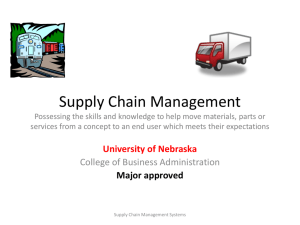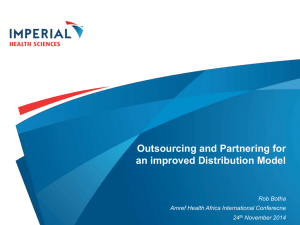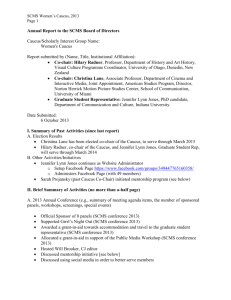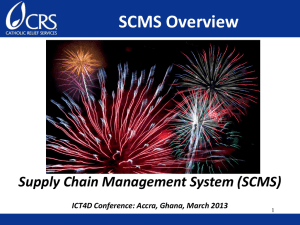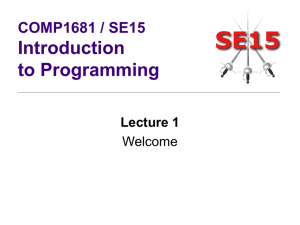IT Use for Exploration
advertisement
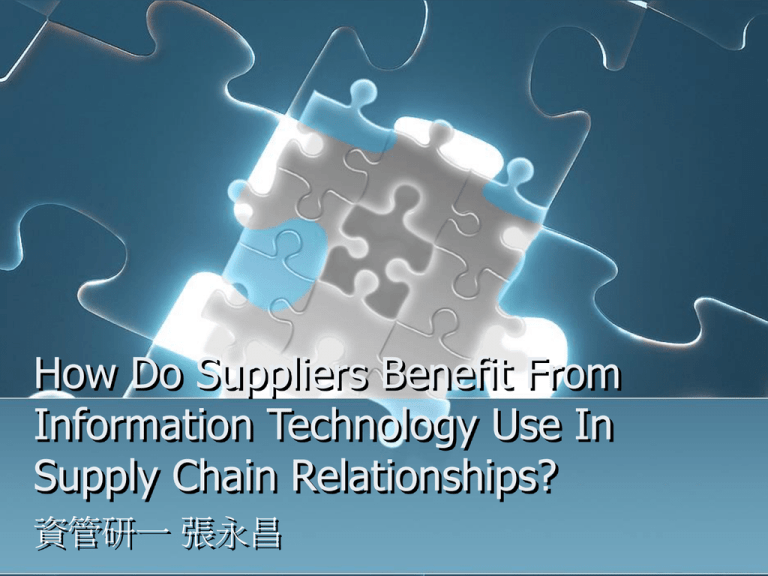
How Do Suppliers Benefit From Information Technology Use In Supply Chain Relationships? 資管研一 張永昌 Agent Abstract Introduction Theoretical Background Methods Results Discussion and Conclusions Abstract Two patterns of SCMS use by suppliers: Exploitation(開發) Exploration(調查) Data:131 suppliers using an SCMS implemented The results support the vendors-to-partners thesis that IT deployments in supply chains leads to closer buyer-supplier relationships (Bakos and Brynjyolfsson 1993) Introduction(1) Early forms of interorganizational systems (IOS) primarily supported the automation of manual processes such as ordering and settling accounts (Riggins and Mukhopadhyay 1994) A range of new features for information sharing, communication, and collaboration has subsequently enhanced these systems (IcasatiJohanson and Fleck 2003) Estimates suggest that over 30,000 IOS are currently in use, supporting a large proportion of business-to-business transactions (Harris 2001). Introduction(2) Network leaders:Chrysler、Dell、Ford、Wal-Mart Benefits from these information technologies are unevenly distributed and skewed in favor of the network leader (Riggins and Mukhopadhyay 1994). network leaders seem to benefit at the expense of supplier firms (Carter 1990; Clemons and Row 1993), often by shifting activities and costs to them. This paper draw on organizational theories(組織 理論) and transaction cost economics(交易成本 理論) to examine supplier benefits from SCMS use. Introduction(3) This work contributes to the literature in three ways: it focuses on the supplier perspective in ITmediated supplier-retailer interactions and highlights the benefits to suppliers from IT use. it theorizes two patterns of use of supply chain technologies–for exploitation and for exploration– and highlights the implications of these appropriation choices for relationship-specific supplier investments and supplier benefits. it theorizes the role of relationship-specific intangible investments in enabling suppliers to both generate value and obtain benefits from SCMS use. H4 H1 H4 H3a H3b H2 H6 H5 H5 H7 Theoretical Background Patterns of SCMS Use Prior examinations of IOS reveal multiple goals motivating their use: providing management support, reducing operational costs, improving customer service, and gaining competitive advantages (Chatfield and Yetton 2000; Crook and Kumar 1998; El Sawy, Malhotra, Gosain and Young 1999; Premkumar, Ramamurthy, and Crum 1997). The paper draw from a theory of learning and action that suggests actions in organizations can be categorized as either exploitation or exploration (March 1991) Exploitation 開發 Exploration 調查 Goal目的 improve operational efficiencies (e.g., through increased standardizati on, tighter process controls, and reduced manual intervention) Learn about the environment and discover novel ways of creating value or solving old problems. Task orientations任 務方針 application of variancereducing strategies to streamline activities, perform them efficiently with a high level of consistency, and achieve greater control over process execution application of varianceseeking strategies to reassess current approaches to problems and to develop novel solutions Table 1: Patterns of IT Use by Suppliers IT Use for Exploitation:Execution of Structured Interfirm Processes IT Use for Exploration:Execution of Unstructured Interfirm Processes Goals: Improving, applying, and incrementally refining firm capabilities. Outcomes: Clearly definable benefits, e.g., cost reduction, process consistency, process efficiency. Goals: Creating new capabilities, devising novel solutions to current problems. Outcomes: ‘Soft’ benefits that are difficult to evaluate in advance (e.g., shared understanding, clearer picture of cause-effect relationships, greater understanding of operating environment). Examples of IT Use for Exploitation Examples of IT Use for Exploration Request for Quotation(RFQ) received electronically by suppliers. Support documents such as detailed part drawings and quality specifications made available online. Analysis of point-of-sale data to understand patterns in customer preferences, patterns in the sale of complementary products. Analysis of product-return data to detect issues to be addressed at retail store level (e.g., problems in handling, displaying products). Electronic Transmission of Purchase Orders, Electronic Transmission of Advanced Shipment Notification (ASN). Scheduling delivery windows at warehouse loading docks. Communicating with repair and service personnel of retailer to diagnose problems encountered in the field. Interactions between supplier’s engineering group and retailer’s service division on diagnosing component failures to inform product redesign, new product design. Examples of IT Use for Exploitation Examples of IT Use for Exploration Electronic Payment Settlement Advice, Communicating with retail issued in predefined intervals after documentation group to improve material receipt. service manuals and customer manuals. Transmission of order status reports (e.g., to alert retailer about unanticipated delays, ability to advance ship ‘hot’ items). Communication between product designers and retail buyers related to new features to be incorporated to improve product’s appeal Electronic notification of changes (e.g., product specifications, changes to packaging and shipping procedures, specification of Purchase Order quantities). Interaction between retail planners and supplier's managers to decide stocking levels for different products, size allocations to different stores. Inventory alerts based on preset ‘triggers’ to communicate stocking levels of products in warehouses. Ad-hoc communications between supplier and retailers' buying and merchandizing groups (e.g., to signal competitive activity such as special promotions or to respond to stock-outs from unanticipated product demand). Theoretical Background Relationship-Specific Intangible Assets Transaction cost economics suggests that relationship-specific investments are important sources of value creation in interfirm exchanges (Williamson 1995). The focus in this paper is on supplier investments that create two types of intangible asset specificity: business-process specificity domain-knowledge Theoretical Background Business-Process Specificity Business-process specificity is the degree to which a supplier’s key business processes such as operating processes, administrative processes, and quality-control processes are particular to the requirements of the focal firm4 in the relationship (Subramani and Venkatraman 2003). Business-process specificity is an important factor linked to performance in interfirm relationships (Dyer 1996b; Mukhopadhyay and Kekre 2002; Zaheer and Venkatraman 1994). Theoretical Background Domain-Knowledge Specificity Domain-knowledge specificity is the degree to which a supplier’s critical expertise such as competitive analysis and strategy formulation and new-product development are particular to the requirement of the focal firm in the relationship (Subramani and Venkatraman 2003). Domain-knowledge specificity is reflected in instances of firms relying on suppliers for innovations and for inputs in critical decisions (Dyer and Singh 1998). Theoretical Background Business-Process Specificity and SCMS Use for Exploitation Greater levels of SCMS use for exploitation (ITExploit)–using the system to perform structured, repetitive tasks–are accompanied by changes to interorganizational business processes (Clark and Stoddard 1996). Theoretical Background Business-Process Specificity and SCMS Use for Exploitation H1: The higher the level of SCMS use for exploitation, the greater the level of businessprocess specificity in the exchange. H1 IT Use for Exploitation Business-process Specificity Theoretical Background Domain-Knowledge Specificity and SCMS Use for Exploitation SCMS use for exploration (ITExplore) occurs via the reporting and messaging features of the SCMS. Greater levels of ITExplore reflect increasing reliance on an SCMS for unstructured tasks by suppliers. Theoretical Background Domain-Knowledge Specificity and SCMS Use for Exploitation H2: The higher the level of SCMS use for exploration, the greater the level of domainknowledge specificity in the exchange. H2 IT Use for Exploration Domain-knowledge Specificity Theoretical Background Relative Influence of SCMS Use on Relationship-Specific Investments Higher levels of ITExplore (e.g., greater communication with the merchandizing group or the quality-control group) allow suppliers to become aware of shortcomings in their business processes and learn about the advantageous business practices adopted by other suppliers (Dyer and Nobeoka 2000; Dyer and Singh 1998). Theoretical Background Relative Influence of SCMS Use on Relationship-Specific Investments H3a: The association of ITExploit with business-process specificity is stronger than the association of ITExplore with business-process specificity. H3a IT Use for Exploitation IT Use for Exploration Business-process Specificity Theoretical Background Relative Influence on Domain-Knowledge Specificity ITExploit can reveal information about retailer processes that are articulated and formalized in implementing the SCMS. Even in routine use of SCMS for structured interorganizational processes (e.g., to transmit quality-control reports), suppliers may become aware over time of the retailer’s internal processes for formulating quality standards, the subjective judgments involved in quality-control procedures, the individuals charged with making these judgments, and the discretion to permit exceptions possessed by individuals in the quality-management group. Theoretical Background Relative Influence on Domain-Knowledge Specificity H3b: The association of ITExplore with domain-knowledge specificity is stronger than the association of ITExploit with domainknowledge specificity. IT Use for Exploitation H3b IT Use for Exploration Domain-knowledge Specificity Theoretical Background Linking SCMS Use to Benefits:Mediation by Relationship-Specific Intangible Investments H4: The higher the level of SCMS use for exploitation, the higher the levels of operational and strategic benefits achieved through the leverage of relationship-specific business processes. Business-process Specificity H4 Operational Benefits Strategic Benefits Theoretical Background Linking SCMS Use to Benefits:Mediation by Relationship-Specific Intangible Investments H5: The higher the level of SCMS use for exploration, the higher the levels of operational and strategic benefits achieved through the leverage of relationship-specific domain knowledge. Operational Benefits H5 Domain-knowledge Specificity Strategic Benefits Theoretical Background Linking SCMS Use to Benefits:Mediation by Relationship-Specific Intangible Investments H6: Higher levels of operational benefits in the exchange are associated with higher levels of competitive performance. Operational Benefits H6 Competitive Performance Theoretical Background Linking SCMS Use to Benefits:Mediation by Relationship-Specific Intangible Investments H7: Higher levels of strategic benefits in the exchange are associated with higher levels of competitive performance. Competitive Performance Strategic Benefits H7 Theoretical Background Control Variables To discount rival hypotheses, the model incorporates four variables influencing supplier benefits: Product uncertainty(產品的不確定性) retailer replaceability(零售商的替換性) supplier size(供應商的規模) length of association between firms(兩家 公司合作時間長久度) Theoretical Background Control Variables Product uncertainty(產品的不確定性) Uncertainty arising from shorter product life cycles increases information processing demands in relationships (Bensaou and Venkatraman 1995). Theoretical Background Control Variables retailer replaceability(零售商的替換性 ) Low levels of retailer replaceability can reflect a cooperative climate in the relationship and therefore be positively related to supplier benefits (Dyer and Singh 1998). Theoretical Background Control Variables supplier size(供應商的規模) Including firm size in the model controls for factors such as relative bargaining power and size of the resource base that can affect supplier benefits (Zaheer and Venkatraman 1994). Theoretical Background Control Variables length of association between firms( 兩家公司合作時間長久度) Including the length of association as a control variable has two advantages. First, it helps control for the potential effects of relationship duration on supplier benefits. Second, it controls for recursive relationships, if any, between dependent and independent variables (Subramani and Venkatraman 2003). Methods Data Data:Canada-Alpha Alpha has a reputation for carrying high-quality products and using rigorous supplier qualification and audit processes. The SCMS was a proprietary system developed by Alpha. Methods Response Rate and Nonresponse Bias The final survey instrument:mail 640 supplier firms Respondents:211(33%) Use the SCMS:131(62%) (在最近2年 內有使用SCMS與Alpha公司做交易) Methods Data Analysis PLS Graph:用來評估quality(品質)和 measurement(測量) Methods Testing Direct Effects Hypotheses postulating direct effects between constructs (H1, H2, H6, and H7) based on the magnitude and significance of paths computed by PLS Graph. I tested hypotheses regarding difference in the strengths of multiple paths (H3a, H3b) by comparing the path magnitudes calculated by PLS. Methods Testing Mediated Effects The mediation hypotheses (H4, H5) in two ways. The first approach compares the research model (with mediated paths from SCMS use to benefits) to a competing model (incorporating a direct link between the constructs). Because the two models are nested, model-comparison procedures using PLS results enable statistical conclusions to be reached regarding model fit. The second approach uses mediation-analysis techniques (Baron and Kenny 1986; Hoyle and Kenny 1999) to calculate the magnitude and significance of individual mediated paths based on values of standardized direct paths computed in PLS. Results 經由PLS Graph及表2的中位數、標準差 ,針對H1~H7假設做驗證。 假設 結果 Hypothesis 1 Supported path = 0.22, t = 2.42, p < .01 Positive Significant Hypothesis 2 Supported path = 0.44, t = 5.77, p < .01 Positive Significant Hypothesis 3a Supported difference = 0.173, t = 1.86, p < 0.05 Positive Significant Hypothesis 3a Supported difference = 0.243, t = 3.30, p < .01 Positive Significant Hypothesis 4 Supported Positive Significant Hypothesis 5 Supported Hypothesis 6 Not Supported path = 0.010, t = 0.1, ns Hypothesis 7 Supported path = 0.265, t = 3.291, p < .01 Not Significant Positive Significant Discussion and Conclusions The study contributes to the literature by providing evidence: suppliers benefit by participating in supply chain management initiatives of network leaders benefits from SCMS use are mediated by suppliers’ deployment of relationship-specific business processes and domain knowledge in the exchange the profile of relationship-specific investments is linked to patterns of SCMS use
